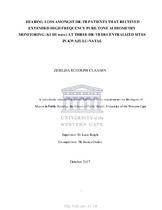| dc.description.abstract | Ototoxic induced hearing loss is a common adverse event related to aminoglycosides used in Multi Drug Resistant -Tuberculosis treatment. Exposure to ototoxic drugs damages the structures of the inner ear. Symptomatic hearing loss presents as tinnitus, decreased hearing, a blocked sensation, difficulty understanding speech, and perception of fluctuating hearing, dizziness and hyperacusis/recruitment. The World Health Organization (1995) indicated that most cases of ototoxic hearing loss globally could be attributed to treatment with aminoglycosides.
The aim of the study was to determine the proportion of DR-TB patients initiated on treatment at three decentralized sites during a defined period (1st October to 31st December 2015) who developed ototoxic induced hearing loss and the corresponding risk factors, whilst receiving audiological monitoring with an extended high frequency audiometer (KUDUwave).
A retrospective cross-sectional study was conducted. Cumulatively across the three decentralized sites, 69 patient records were reviewed that met the inclusion criteria of the study. The mean age of the patients was 36.1, with a standard deviation (SD) of 10.7 years; more than half (37) were female. Ototoxicity , a threshold shift, placing patients at risk of developing a hearing loss was detected in 56.5% (n=39)of patients and not detected in 30.4%(n=21).The remaining 13,1% (n=9)is missing data. As a result, the regimen was adjusted in 36.2% of patients. .
From the 53 patients who were tested for hearing loss post completion of the injectable phase of treatment, 22.6% (n=12) had normal hearing, 17.0 % (n=9) had unilateral hearing loss, and 60.4% (n=32) had bilateral hearing loss. Therefore, a total of 41 patients had a degree of hearing loss: over 30% (n=22)had mild to moderate hearing loss, and only about 15% (n=11)had severe to profound hearing loss. Analysis of risk factors showed that having ototoxicity detected and not adjusting regimen significantly increases the risk of patients developing a hearing loss.
The key findings of the study have shown that a significant proportion of DR-TB patients receiving an aminoglycoside based regimen are at risk of developing ototoxic induced hearing loss, despite receiving audiological monitoring with an extended high frequency audiometer that allows for early detection of ototoxicity (threshold shift). | en_US |

